Although sponges are very simple animals, there are some complex specializations to their bodies. They have a large internal cavity, oscula, ostia, amoebocytes, choanocytes, and mesohyl. All of these have their own special purpose in the sponge. You can read about this by clicking each tab in the activity below. Be sure to note the job of each sponge part and how these parts relate to the way the body of a sponge functions as a whole.
Ostia
Choanocytes
Amoebocytes
Oscula
Epidermal Cells
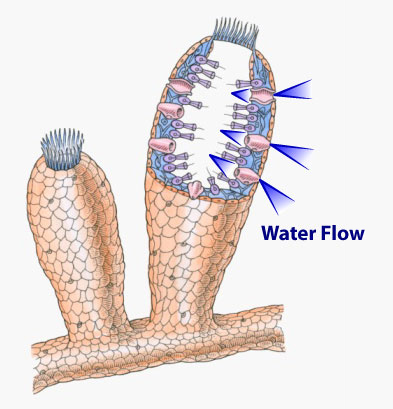
These pores on the surface of the sponge are the site of water entry. The arrows on the image indicate the flow of water into the sponge. Notice that water travels from outside the sponge, in through the ostia, and in to the internal cavity of the sponge. The water carries with it the sponge's food, which is tiny unicellular organisms, such as plankton and algae. Ostia are also where sperm cells can enter the sponge during times of sexual reproduction.
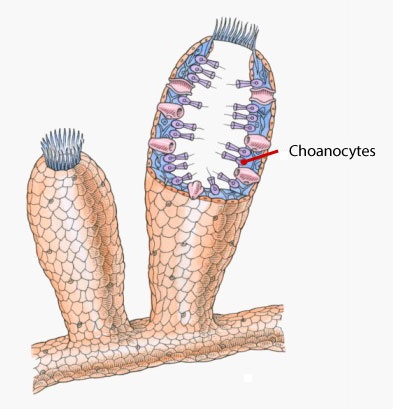
After water and food particles enter the ostia, they arrive inside the large internal cavity, lined by choanocytes, colored in purple in the image. The flagella (the tail-like structures) of the collar cells extend into the body cavity, and it is the beating of this flagella that draw the water in through the ostia. The "collar" of the choanocytes actually has tiny hairs that trap the food. The tiny trapped organisms are then taken up by the collar cells via endocytosis, meaning the food is digested right away inside the cell.
What two parts of the choanocytes are essential for sponge survival? Why? Think about the answer, then click "Show Me" to see if you are correct.

The flagella are important for drawing in water and food into the sponge. The "collar" of the choanocytes is important for trapping then digesting the food.
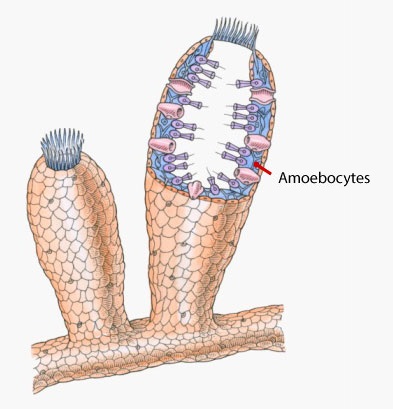
The amoebocytes (colored blue in the image) are situated in the mesohyl, in between the choanocytes and the epidermal cells. Amoebocytes move like amoebas within the mesohyl, picking up nutrients from the choanocytes that digested the food particles. The amoebocytes deliver the nutrients to the other cells within the sponge. The amoebocytes then take waste away from these cells.
Since choanocytes are the only sponge cells to digest food, how are all the other sponge cells provided with the necessary nutrients? Think about the answer, then click "Show Me" to see if you are correct.

Amoebocytes pick up nutrients from choanocytes and deliver the nutrients to all the other cells within the sponge.
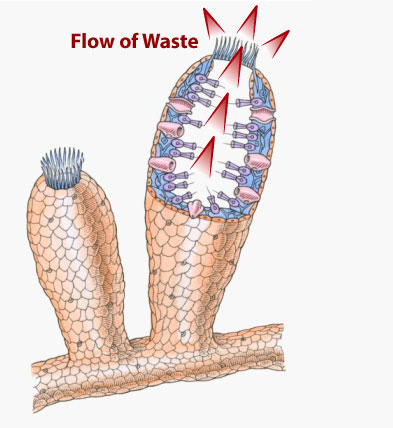
The two openings on the top of the sponge, surrounded by the hair-like projections, are the oscula. Waste exits the cavity of the sponge through these large openings, as shown by the arrows.
The oscula are the large openings of the sponge through which water exits. As the water exits, it takes with it all the waste taken out by the amoebocytes. The openings at the top of the sponge pictured are the oscula.
What is the difference in function between the ostia and the osculum? Think about the answer, then click "Show Me" to see if you are correct.

The ostia are where water is drawn inside the sponge and the osculum is where water and waste exit the sponge.
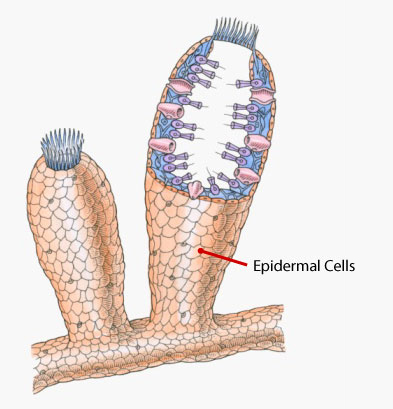
The epidermal cells, colored tan in the image, can slightly change the shape of the sponge by expanding or contracting. They are also tightly packed together, providing a protective outer layer for the sponge.
In the activity below, read the definition and think of the word it is describing. When you have an answer, click the flashcard to reveal the correct answer. If you feel comfortable with the information, click Remove to take that card out of the deck. If you still need to review the information, click the Next to review that item again.
where water and food enter a sponge
ostia
where water and waste exit the sponge
osculum
traps and digests food for the sponge
choanocyte
carries nutrients to sponge cells and takes their waste away
amoebocyte
makes up the protective layer of cells on the outer surface of the sponge
epidermal cells
its movement draws water into the sponge
choanocyte flagella
jelly-like substance in which the amoebocytes move
mesohyl
Cards remaining:
